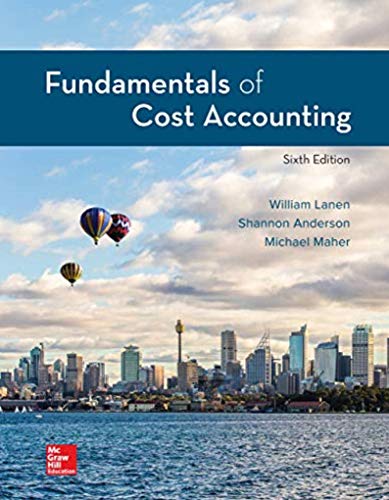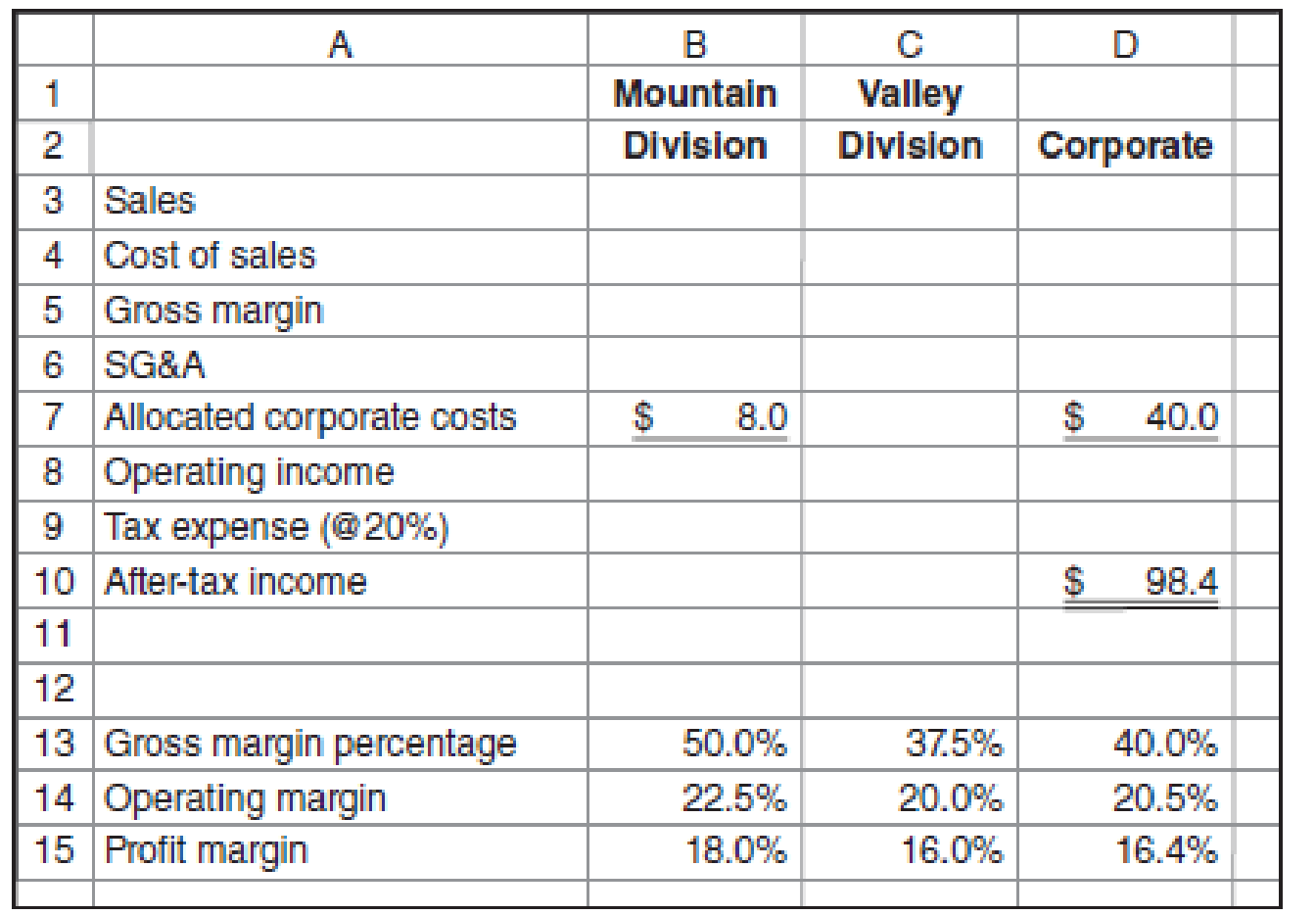
Computing Divisional Income: Incomplete Information and Financial Ratios
As a part of an employment interview, you are given the partial income statement and selected financial ratios shown for Sneaky Pete’s, a chain of western stores. Sneaky Pete’s is organized into two divisions: Mountain and Valley. You are told that corporate

Required
- a. Complete the income statements for both divisions and the corporation as a whole.
- b. What recommendation(s) would you make about computing divisional income for divisional performance measurement at Sneaky Pete’s?
a.
Complete the income statements for both divisions along with the corporation as a whole.
Explanation of Solution
Divisional income statement:
The divisional income statement shows the income of various divisions of the business. It calculates the operating profit of the division by subtracting the expenses of the business from the sales of the division.
Calculate the divisional income statement for mountain division, valley division and corporate:
|
Company S Divisional Income Statement | |||
| Particulars | Mountain division | Valley division | Corporate |
| Sales | $120.00(6) | $480.00(7) | $600.00(1) |
| Cost of sales | $60.00(10) | $300.00(10) | $360.00(4) |
| Gross margin | $60.00(8) | $180.00(8) | $240.00(3) |
| SG&A | $25.00(9) | $52.00(5) | $77.00(5) |
| Allocated corporate costs | $8.00 | $32.00(11) | $40.00 |
| Operating income(a) | $27.00(8) | $96.00(8) | $123.00(2) |
| Tax expenses | $5.40 | $19.20 | $24.60 |
| After tax profit | $21.60 | $76.80 | $98.40 |
Table: (1)
Working note 1:
Calculate the overall corporate sales:

Working note 2:
Calculate the operating income:

Working note 3:
Calculate the gross margin:
Working note 4:
Calculate the cost of sales:
Working note 5:
Calculate the SG&A:
Working note 6:
Calculate the sales for mountain division:
The allocated corporate costs are allocated on the basis of sales. The sales level is $600 on the costs of $40, and it will be computed as follows for the costs of $8:
Working note 7:
Calculate the sales for valley division:
Working note 8:
Calculate the gross and operating income for both the divisions:
| Particulars |
Sales (a) |
Gross margin (b) |
Operating margin (c) |
Gross margin |
Operating profit |
| Mountain division | $120 | 50% | 23% | $60 | $27 |
| Valley division | $480 | 38% | 20% | $180 | $96 |
Table: (2)
Working note 9:
Calculate the SG&A:
Working note 10:
Calculate the cost of sales:
| Particulars | Sales | Gross margin | Cost of sales |
| Mountain division | 120 | 50% | $60 |
| Valley division | 480 | 38% | $298 |
Table: (3)
Working note 11:
Calculate the allocated corporate costs:
b.
Provide recommendations to Company S.
Explanation of Solution
Recommendations to company S:
Company S should not allocate the corporate cost to the divisions. It is not a division specific cost so it should not be allocated on the basis of the revenue of the unit.
Thus, Company S should not allocate the corporate cost to the mountain division and valley division.
Want to see more full solutions like this?
Chapter 14 Solutions
Fundamentals Of Cost Accounting (6th Edition)
- Kanye Achebe just became the operations manager of Weston Transportation. Weston transports large crates for online companies and transports containers overseas. Kanye would like to evaluate each divisional manager on a basis similar to segmental reporting required by generally accepted accounting principles (GAAP) financial statements contained in annual reports. These data include a presentation of net sales, operating profit and loss before and after taxes, total identifiable assets, and depreciation for segment reported. Kanye thinks that evaluating business division managers by the same criteria as the total company is appropriate. A. Explain why you think the chief financial officer (CFO) disagrees and tells Kanye that publicly reporting information might demotivate managers. B. For better evaluation of the managers, what type of information should Kanye propose that the CFO might accept?arrow_forwardCOMPUTING OPERATING INCOME The sales, cost of goods sold, and total operating expenses of departments A and B of Ash Company are as follows: Compute the departmental operating income for each department.arrow_forwardProfit center responsibility reporting for a service company Red Line Railroad Inc. has three regional divisions organized as profit centers. The chief executive officer (CEO) evaluates divisional performance, using operating income as a percent of revenues. The following quarterly income and expense accounts were provided from the trial balance as of December 31: The company operates three support departments: Shareholder Relations, Customer Support, and Legal. The Shareholder Relations Department conducts a variety of services for shareholders of the company. The Customer Support Department is the companys point of contact for new service, complaints, and requests for repair. The department believes that the number of customer contacts is a cost driver for this work. The Legal Department provides legal services for division management. The department believes that the number of hours billed is a cost driver for this work. The following additional information has been gathered: Instructions 1. Prepare quarterly income statements showing operating income for the three divisions. Use three column headings: East, West, and Central. 2. Identify the most successful division according to the profit margin. Round to the nearest whole percent. 3. Provide a recommendation to the CEO for a better method for evaluating the performance of the divisions. In your recommendation, identify the major weakness of the present method.arrow_forward
- Consider the following list of scorecard measures: a. Product profitability b. Ratings from customer surveys c. Number of patents pending d. Strategic job coverage ratio e. Revenue per employee f. Quality costs g. Percentage of market h. Employee turnover percentages i. First-pass yields j. On-time delivery percentage k. Percentage of revenues from new sources l. Economic value added Required: Classify each measure according to the following: perspective, financial or nonfinancial, subjective or objective, and external or internal. When the perspective is process, identify which type of process: innovation, operations, or post-sales service.arrow_forwardAs manager of department B in MarIeys Manufacturing, based on the costs you identified in the previous exercise for further research, how does this impact the financial performance of your department, and what might be some questions you want to ask or solutions you might propose to Marleys management?arrow_forwardUsing the data for Lee Company from problem 24-2 above along with the following data,determine the divisional income from operations for the Division and the CommercialDivision:arrow_forward
- Following items belong to the revenue, expenditure, human resources/payroll, production, or financing cycle. Classify each item based on the cycle it belongs to. a. Pay pay-as-you-earn (PAYE) payroll taxes b. Send material requisition to inventory c. Issue stock to investors d. Borrow money from the bank to purchase a new factory e. Complete receiving report f. Appoint replacement purchasing clerk g. Measure employee performance using a performance management system h. Choose suitable supplier of raw materials i. Ensure employees are up to date with the latest tax provisions j. Record personal and tax information for new employeesarrow_forwardAssume you have been hired by Cabelas Sporting Goods. As part of your new role in the accounting department, you have been tasked to set up a responsibility accounting structure for the company. As your first task, your supervisor has asked you to give an example of a cost center, profit center, and an investment center within the Cabelas organization. Your supervisor is a little unsure of the difference between a profit center and investment center and would like you to explain the difference.arrow_forwardCustomers as a Cost Object Morrisom National Bank has requested an analysis of checking account profitability by customer type. Customers are categorized according to the size of their account: low balances, medium balances, and high balances. The activities associated with the three different customer categories and their associated annual costs are as follows: Additional data concerning the usage of the activities by the various customers are also provided: Required: (Note: Round answers to two decimal places.) 1. Calculate a cost per account per year by dividing the total cost of processing and maintaining checking accounts by the total number of accounts. What is the average fee per month that the bank should charge to cover the costs incurred because of checking accounts? 2. Calculate a cost per account by customer category by using activity rates. 3. Currently, the bank offers free checking to all of its customers. The interest revenues average 90 per account; however, the interest revenues earned per account by category are 80, 100, and 165 for the low-, medium-, and high-balance accounts, respectively. Calculate the average profit per account (average revenue minus average cost from Requirement 1). Then calculate the profit per account by using the revenue per customer type and the unit cost per customer type calculated in Requirement 2. 4. CONCEPTUAL CONNECTION After the analysis in Requirement 3, a vice president recommended eliminating the free checking feature for low-balance customers. The bank president expressed reluctance to do so, arguing that the low-balance customers more than made up for the loss through cross-sales. He presented a survey that showed that 50% of the customers would switch banks if a checking fee were imposed. Explain how you could verify the presidents argument by using ABC.arrow_forward
- Rocky Mountain Airlines Inc. has two divisions organized as profit centers, the Passenger Division and the Cargo Division. The following divisional income statements were prepared: The support department allocation rates for the support department costs were based on revenues. Because the revenues of the two divisions were the same, the support department allocations to each division were also the same. The following additional information is available: a.Does the operating income (loss) for the two divisions accurately measure performance? Explain. b.Correct the divisional income statements, using appropriate support department cost drivers.arrow_forwardCorrections to service department charges Panda Airlines Inc. has two divisions organized as profit centers, the Passenger Division and the Cargo Division. The following divisional income statements were prepared The service department charge rate for the service department costs was based on revenues. The following additional information is available a.Does the operating income for the two divisions accurately measure performance? b.Using service charge rates for service department charges, correct the divisional income statements.arrow_forwardThe following information is from Good Read Books. Good Read is a regional book store with three regional stores. The May income statement for all stores is shown. A. Comment on the operating income results for each store. B. Now assume the costs allocated from corporate is an uncontrollable cost for each store. How does this change your assessment of each store?arrow_forward
 Cornerstones of Cost Management (Cornerstones Ser...AccountingISBN:9781305970663Author:Don R. Hansen, Maryanne M. MowenPublisher:Cengage Learning
Cornerstones of Cost Management (Cornerstones Ser...AccountingISBN:9781305970663Author:Don R. Hansen, Maryanne M. MowenPublisher:Cengage Learning Financial And Managerial AccountingAccountingISBN:9781337902663Author:WARREN, Carl S.Publisher:Cengage Learning,
Financial And Managerial AccountingAccountingISBN:9781337902663Author:WARREN, Carl S.Publisher:Cengage Learning, Managerial AccountingAccountingISBN:9781337912020Author:Carl Warren, Ph.d. Cma William B. TaylerPublisher:South-Western College Pub
Managerial AccountingAccountingISBN:9781337912020Author:Carl Warren, Ph.d. Cma William B. TaylerPublisher:South-Western College Pub- Principles of Accounting Volume 2AccountingISBN:9781947172609Author:OpenStaxPublisher:OpenStax CollegeCentury 21 Accounting Multicolumn JournalAccountingISBN:9781337679503Author:GilbertsonPublisher:Cengage
 College Accounting, Chapters 1-27AccountingISBN:9781337794756Author:HEINTZ, James A.Publisher:Cengage Learning,
College Accounting, Chapters 1-27AccountingISBN:9781337794756Author:HEINTZ, James A.Publisher:Cengage Learning,





